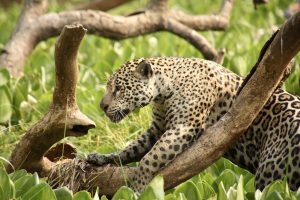 A couple of weeks before we left on this trip, we saw a documentary on the jaguars in the Pantanal in Brazil. These big cats (third biggest in the world) have been ‘with us’ since we drove into southern Mexico. However due to their dwindling numbers and secretive life style, seeing one in the wild is extremely difficult. In the documentary, we learned that there is one place in Brazil (Porto Jofre – Mato Grosso) where they are fairly often seen near a river. I immediately started investigating if we could somehow fit a visit to this place in our South American itinerary. The place is rather remote so it was going to take an effort and a lot of extra (about 4000) kilometers to get there
A couple of weeks before we left on this trip, we saw a documentary on the jaguars in the Pantanal in Brazil. These big cats (third biggest in the world) have been ‘with us’ since we drove into southern Mexico. However due to their dwindling numbers and secretive life style, seeing one in the wild is extremely difficult. In the documentary, we learned that there is one place in Brazil (Porto Jofre – Mato Grosso) where they are fairly often seen near a river. I immediately started investigating if we could somehow fit a visit to this place in our South American itinerary. The place is rather remote so it was going to take an effort and a lot of extra (about 4000) kilometers to get there
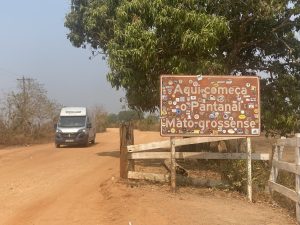 After a day of driving nicely paved roads (a huge relief after the hellish exit from Bolivia) and going from one place to another to get all the Bolivia to Brazil customs and immigration admin settled, we arrive just before sunset at the start of the ‘Trans Pantaneira’. This ‘dead-end’ road is a 170km gravel road from the last town Pocone to the Cuiabá river and the small settlement Porto Jofre. Along the way there are only farms and wetlands.
After a day of driving nicely paved roads (a huge relief after the hellish exit from Bolivia) and going from one place to another to get all the Bolivia to Brazil customs and immigration admin settled, we arrive just before sunset at the start of the ‘Trans Pantaneira’. This ‘dead-end’ road is a 170km gravel road from the last town Pocone to the Cuiabá river and the small settlement Porto Jofre. Along the way there are only farms and wetlands.
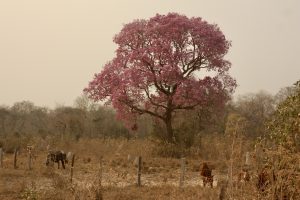 But the wetlands do not look like wetlands at all. The past year, during the 6 months wet season there has been hardly any rain. Since 2019, there has been a lot less rain than usual. But the last year has been extreme with only a couple of days of rain. Everything is dry. Not only have all the pools have dried up but even most secondary rivers only have a couple of puddles of water left. The Pantanal (actually the whole country) is also experiencing the worst wildfires ever. Scientist think this is not only due to global warming but also due to microclimates being disrupted by the massive deforestation…and this might be irreversible within the next century.
But the wetlands do not look like wetlands at all. The past year, during the 6 months wet season there has been hardly any rain. Since 2019, there has been a lot less rain than usual. But the last year has been extreme with only a couple of days of rain. Everything is dry. Not only have all the pools have dried up but even most secondary rivers only have a couple of puddles of water left. The Pantanal (actually the whole country) is also experiencing the worst wildfires ever. Scientist think this is not only due to global warming but also due to microclimates being disrupted by the massive deforestation…and this might be irreversible within the next century.
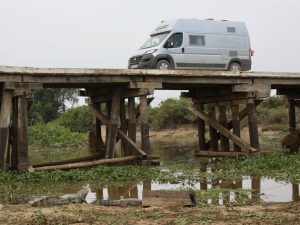 We spend three days driving down to Porto Jofre. The road conditions vary between horrific washboard and very smooth parts. There are over 50 bridges on the road. The majority is now concrete but there are still some of the original creaking wooden bridges. We mostly wild camp in pull outs along the road or by little rivers. To see a maximum of wildlife we only drive from 6am to 9am and from 3pm to sunset at 5.30pm. In between we do as the animals do, we look for a shady spot to hide for a couple of hours. In the afternoon of the 3rd day, we see a spotted medium size cat on the road in the distance. Could it be a first jaguar? We try to approach stealthy to get a better view but a rental car overtakes us at full speed and we see the animal flee in the bushes and don’t see it again. Was it a young jaguar? It sure looked like that. We look for footprints, but only find smaller prints. Wildlife expert Leon teaches us that adult jaguars leave footprints “the size of an American pancake”. We don’t find any of those.
We spend three days driving down to Porto Jofre. The road conditions vary between horrific washboard and very smooth parts. There are over 50 bridges on the road. The majority is now concrete but there are still some of the original creaking wooden bridges. We mostly wild camp in pull outs along the road or by little rivers. To see a maximum of wildlife we only drive from 6am to 9am and from 3pm to sunset at 5.30pm. In between we do as the animals do, we look for a shady spot to hide for a couple of hours. In the afternoon of the 3rd day, we see a spotted medium size cat on the road in the distance. Could it be a first jaguar? We try to approach stealthy to get a better view but a rental car overtakes us at full speed and we see the animal flee in the bushes and don’t see it again. Was it a young jaguar? It sure looked like that. We look for footprints, but only find smaller prints. Wildlife expert Leon teaches us that adult jaguars leave footprints “the size of an American pancake”. We don’t find any of those.
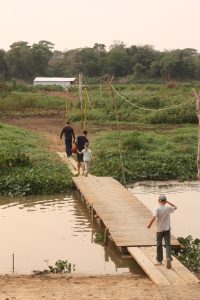 After 3 days, we get to Porto Jofre and after all the dry cow lands and dusty roads, we finally see the green wetlands at the banks of the river. We book a boat tour the next day to go search for the jaguars! At 6 am we set off on the river with the rising sun. We quickly spot an impressive river otter and some cool birds. Being in the wetlands means that there are going to be a lot of birds. The toco toucans, parrots and jaribu can be seen everywhere in the Pantanal. We had also seen a couple of Hyacinth macaws earlier. But the aracari, capped heron and green kingfisher we hadn’t seen around here yet.
After 3 days, we get to Porto Jofre and after all the dry cow lands and dusty roads, we finally see the green wetlands at the banks of the river. We book a boat tour the next day to go search for the jaguars! At 6 am we set off on the river with the rising sun. We quickly spot an impressive river otter and some cool birds. Being in the wetlands means that there are going to be a lot of birds. The toco toucans, parrots and jaribu can be seen everywhere in the Pantanal. We had also seen a couple of Hyacinth macaws earlier. But the aracari, capped heron and green kingfisher we hadn’t seen around here yet.
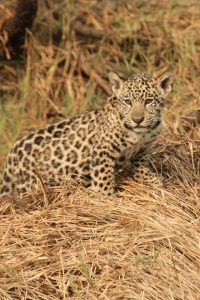 But of course, we are all scanning the banks for something else. And soon enough we spot a congregation of boats looking at a female jaguar with the cutest cub. After they go hiding in the long grass, we decide to go further up the river. Not even 100 m further, we bump into another jaguar. A younger male is walking in the direction of the nest of the mom and cub but it is still the other side of the river. But then it decides to cross the river and swims straight to their hiding place. He’s clearly aware of the presence of the other jaguar…And it does not look like he’s welcome either. We see the mom send her cub away up the bank and into the bushes, while she stays to guard their house. The young male is now within meters of the female. All of a sudden she storms out of her hiding place and leaps on top of the male jaguar. For a couple of seconds they fiercely fight in the high grass just meters away from us, before she emerges triumphant but also scarred. The male keeps hanging around though and it takes three chases before he decides to leave. After that we see the cub cautiously returning to its mother. Another National Geographic moment for our records!
But of course, we are all scanning the banks for something else. And soon enough we spot a congregation of boats looking at a female jaguar with the cutest cub. After they go hiding in the long grass, we decide to go further up the river. Not even 100 m further, we bump into another jaguar. A younger male is walking in the direction of the nest of the mom and cub but it is still the other side of the river. But then it decides to cross the river and swims straight to their hiding place. He’s clearly aware of the presence of the other jaguar…And it does not look like he’s welcome either. We see the mom send her cub away up the bank and into the bushes, while she stays to guard their house. The young male is now within meters of the female. All of a sudden she storms out of her hiding place and leaps on top of the male jaguar. For a couple of seconds they fiercely fight in the high grass just meters away from us, before she emerges triumphant but also scarred. The male keeps hanging around though and it takes three chases before he decides to leave. After that we see the cub cautiously returning to its mother. Another National Geographic moment for our records!
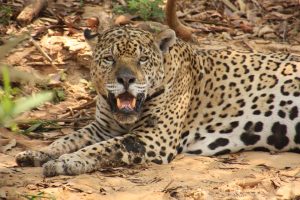 After that we cruise further up the river and quickly bump into jaguar number 4. Unfortunately, here we are late to the party. Other people saw it catch and eat a cayman. By the time we get there, he has eaten the whole thing and is now just able to breathe very hard.
After that we cruise further up the river and quickly bump into jaguar number 4. Unfortunately, here we are late to the party. Other people saw it catch and eat a cayman. By the time we get there, he has eaten the whole thing and is now just able to breathe very hard.
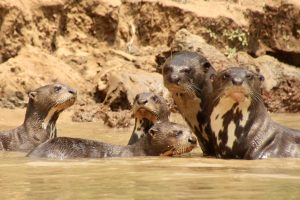 We pass by a ‘giant river otter’ family, all trying to look as mean as possible. They are truly giants: up to 2 meter long! And they are aggressive! They will attack the boat if you get to close. They have even been seen successfully fighting jaguars!
We pass by a ‘giant river otter’ family, all trying to look as mean as possible. They are truly giants: up to 2 meter long! And they are aggressive! They will attack the boat if you get to close. They have even been seen successfully fighting jaguars!
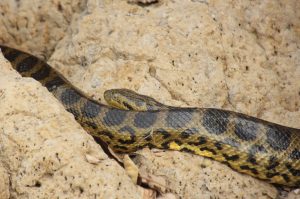 While we slowly start making our way back to Porto Jofre, we spot a 5th jaguar but it quickly retreats in the bushes when we approach. But while we are having lunch on the boat a couple of kms further down the river we hear a jaguar roar again. We can’t see it yet but we are told that it’s looking for trouble. It’s challenging another jaguar. A bit later we see it appear on the banks of the river. It is pouncing up and down the river but its adversary does not appear. It is now time to head back to Porto Jofre. The kids had been really hoping to see an anaconda and on our way back our guide is able to spot one! It isn’t the gigantic green anaconda but its smaller cousin, the yellow anaconda. But it is very impressive (and beautiful) none the less. What an amazing day it has been. We are so happy that we made this big detour for this.
While we slowly start making our way back to Porto Jofre, we spot a 5th jaguar but it quickly retreats in the bushes when we approach. But while we are having lunch on the boat a couple of kms further down the river we hear a jaguar roar again. We can’t see it yet but we are told that it’s looking for trouble. It’s challenging another jaguar. A bit later we see it appear on the banks of the river. It is pouncing up and down the river but its adversary does not appear. It is now time to head back to Porto Jofre. The kids had been really hoping to see an anaconda and on our way back our guide is able to spot one! It isn’t the gigantic green anaconda but its smaller cousin, the yellow anaconda. But it is very impressive (and beautiful) none the less. What an amazing day it has been. We are so happy that we made this big detour for this.
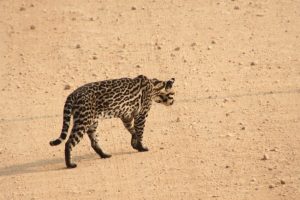 We start the 170km of gravel to get back to civilization still that same day. And again (just like on the way in), we see a cat crossing the road not far in front of us. This time however, we can get a good look and see it is not a young jaguar but its smaller but also beautiful cousin, the Ocelot.
We start the 170km of gravel to get back to civilization still that same day. And again (just like on the way in), we see a cat crossing the road not far in front of us. This time however, we can get a good look and see it is not a young jaguar but its smaller but also beautiful cousin, the Ocelot.
Eventually, we reach the city of Cuiaba and can now continue our drive south towards Argentina and Patagonia. But before we even get to Argentina, we still have a lot of ground to cover in Brazil (where we also want to visit the southern Pantanal). To get from the northern Pantanal to the southern part there is a nice and fast highway. But there is also a slow gravel road, the BR419. We had been doing a lot of (bad) gravel roads the last weeks so we were not tempted to take this road…until we heard all the stories of other travellers that had seen so many cool animals there. The road has been nicked-named ‘anteater road’ as it is one of the best places to spot these creatures.
 And the road lives up to its nick name. In the two days it takes us to drive the 200km of gravel, we spot more than 10 giant anteaters. They are such amazing animals. Very confusing too! Even after watching several of them, my brain would still at times confuse its head for one of its legs. After hearing all the stories of wildlife on this road, we were not expecting that (again) 90 pct of this road would be through endless ‘cow-lands’. But the tapirs, anteaters, nandus just live among the cows. The last part of this road is now being paved. We hope they will not continue further, otherwise this will probably turn into just another Brazilian road kill highway like the one we drive on our way to Bonito.
And the road lives up to its nick name. In the two days it takes us to drive the 200km of gravel, we spot more than 10 giant anteaters. They are such amazing animals. Very confusing too! Even after watching several of them, my brain would still at times confuse its head for one of its legs. After hearing all the stories of wildlife on this road, we were not expecting that (again) 90 pct of this road would be through endless ‘cow-lands’. But the tapirs, anteaters, nandus just live among the cows. The last part of this road is now being paved. We hope they will not continue further, otherwise this will probably turn into just another Brazilian road kill highway like the one we drive on our way to Bonito.
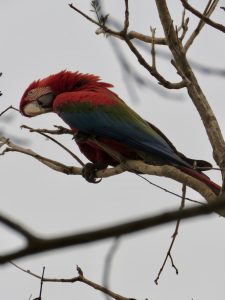 The majority of travelers that visit the Pantanal will come to visit the town of Bonito. Unlike the northern Pantanal this part is very accessible and there are a lot of cool things to do and visit. Lots of visitors unfortunately also means higher prices. We are a bit shocked to see the prices of the excursions (They almost make Costa Rica look cheap). Luckily, we find a nice campground with access to a river where we can go snorkelling. The bird life is amazing all around town. We find back a lot of birds that we had not expected to see again on this trip.
The majority of travelers that visit the Pantanal will come to visit the town of Bonito. Unlike the northern Pantanal this part is very accessible and there are a lot of cool things to do and visit. Lots of visitors unfortunately also means higher prices. We are a bit shocked to see the prices of the excursions (They almost make Costa Rica look cheap). Luckily, we find a nice campground with access to a river where we can go snorkelling. The bird life is amazing all around town. We find back a lot of birds that we had not expected to see again on this trip.
That being said the blue and red macaw takes the prize! After seeing the yellow and blue and the hyacinth macaws earlier, this is our third type of macaw in Brazil (and 5th of the trip).
From Bonito we head to the border with Paraguay. The plan is to drive to the Jesuit missions in the South of Paraguay. But after having crossed into Paraguay, we meet a French family and our kids overhear us talk about the Iguazu falls that we visited in 2012 and now they really want to see them too. Leon especially wants to go there after he watched the movie ‘The mission’, which was filmed at Iguazu falls. So, we change our plans and start heading for Puerto Iguazu.
